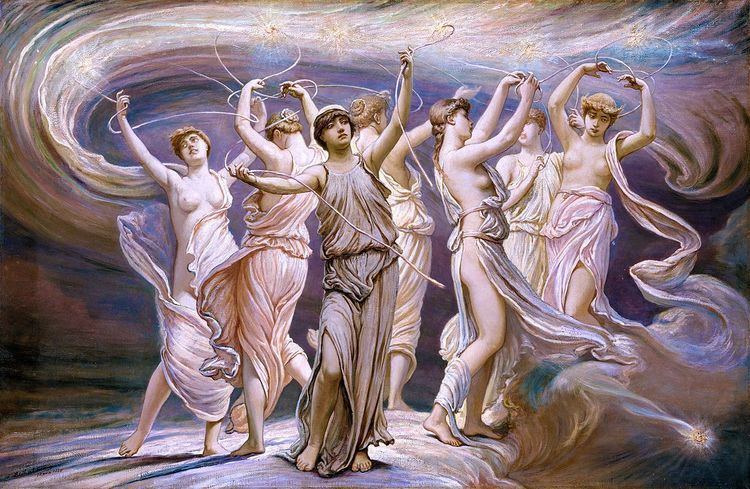 | ||
The Pleiades (/ˈplaɪ.ədiːz/ or /ˈpliːədiːz/; Ancient Greek: Πλειάδες [pleːádes], Modern [pliˈaðes]), companions of Artemis, were the seven daughters of the titan Atlas and the sea-nymph Pleione born on Mount Cyllene. They were the sisters of Calypso, Hyas, the Hyades, and the Hesperides. The Pleiades were nymphs in the train of Artemis, and together with the seven Hyades were called the Atlantides, Dodonides, or Nysiades, nursemaids and teachers to the infant Dionysus. They were thought to have been translated to the night sky as a cluster of stars, the Pleiades, and were associated with rain.
Contents
Etymology
Classicists debate the origin of the name Pleiades. It ostensibly derives from the name of their mother, Pleione, effectively meaning "daughters of Pleione". However, in reality the name of the star-cluster almost certainly came first, and Pleione was invented to explain it. Pleiades probably actually derives from πλεῖν (plein , "to sail") because of the cluster's importance in delimiting the sailing season in the Mediterranean Sea: "the season of navigation began with their heliacal rising".
The Seven Sisters
Several of the most prominent male Olympian gods (including Zeus, Poseidon, and Ares) engaged in affairs with the seven heavenly sisters. These relationships resulted in the birth of their children.
Sometimes they are related to the Hesperides, nymphs of the morning star.
Mythology
After Atlas was forced to carry the heavens on his shoulders, Orion began to pursue all of the Pleiades, and Zeus transformed them first into doves, and then into stars to comfort their father. The constellation of Orion is said to still pursue them across the night sky.
One of the most memorable myths involving the Pleiades is the story of how these sisters literally became stars, their catasterism. According to some versions of the tale, all seven sisters committed suicide because they were so saddened by either the fate of their father, Atlas, or the loss of their siblings, the Hyades. In turn Zeus, the ruler of the Greek gods, immortalized the sisters by placing them in the sky. There these seven stars formed the star cluster known thereafter as the Pleiades.
The Greek poet Hesiod mentions the Pleiades several times in his Works and Days. As the Pleiades are primarily winter stars, they feature prominently in the ancient agricultural calendar. Here is a bit of advice from Hesiod:
"And if longing seizes you for sailing the stormy seas,when the Pleiades flee mighty Orionand plunge into the misty deepand all the gusty winds are raging,then do not keep your ship on the wine-dark seabut, as I bid you, remember to work the land."(Works and Days 618-23)
The Pleiades would "flee mighty Orion and plunge into the misty deep" as they set in the West, which they would begin to do just before dawn during October–November, a good time of the year to lay up your ship after the fine summer weather and "remember to work the land"; in Mediterranean agriculture autumn is the time to plough and sow.
The poet Lord Tennyson mentions the Pleiades in his poem Locksley Hall:
"Many a night I saw the Pleiads, rising through the mellow shade,Glitter like a swarm of fire-flies tangled in a silver braid."The loss of one of the sisters, Merope, in some myths may reflect an astronomical event wherein one of the stars in the Pleiades star cluster disappeared from view by the naked eye.
Alternate version
Although most accounts are uniform as to the number, names, and main myths concerning the Pleiades, the mythological information recorded by a scholiast on Theocritus' Idylls with reference to Callimachus has nothing in common with the traditional version. According to it, the Pleiades were daughters of an Amazonian queen; their names were Maia, Coccymo, Glaucia, Protis, Parthenia, Stonychia, and Lampado. They were credited with inventing ritual dances and nighttime festivals.
